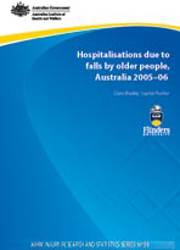Summary
This report is the second in a series of biennial reports on hospitalisations due to falls by older people in Australia. The report focuses on hospitalised falls occurring in the financial year 2005-06 and examines trends in fall-related hospitalisations over the period 1999-2006.
Hospitalised falls 2005–06
- The estimated number of hospitalised injury cases due to falls in people aged 65 years and over was 66,800 - a rise of 10% since 2003-04.
- The age-standardised rate of fall injury cases for older people (2,415 per 100,000 population) has also risen compared to 2003-04 (2,295 per 100,000).
- As in the previous report, older females accounted for most of the hospitalised fall injury cases and a third of cases had injuries to the hip and thigh.
- Similarly, a fall on the same level, due to slipping, tripping and stumbling, was the most common cause of a hospitalised fall.
- Half of all fall injury cases for people aged 65 years and older occurred in the home. Falls in residential institutions were also common.
- Older people who lived in aged care facilities were found to have a rate of falls five times as high as that for people of the same age who lived in the community and fell in their home.
- The first episode of hospital care for a fall injury case (i.e. care for an acute injury) is frequently followed by further episodes of care that can be described as ‘follow-up care’.
- Over 20,000 episodes of fall-related follow-up care were identified for people aged 65 years and older, an increase compared to 2003-04.
Trends in hospitalised fall-related injury 1999–2006
- Age-standardised rates of hospitalised fall-related injury separations have increased over the seven year study period to June 2006, despite a decrease in the rate for femur fractures due to falls.
- The estimated total length of stay per fall injury case has also increased, apparently influenced by increases in the number of bed-days used by episodes of fall-related follow-up care.
- This report shows weakness in commonly used methods for measuring the incidence of serious falls and associated bed-day use from current administrative data. Better measurement, especially of trends, requires use of a method that takes account of all of the episodes of hospital care for a person who has had an injurious fall.



